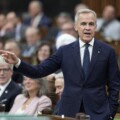Once the political fireworks settle down after Finance Minister Freeland’s surprise resignation, what remains is a budget situation that is following a weaker path than set out in the spring.
The fiscal year (FY) 2024/25 budget deficit is now estimated at $48.3 billion, or 1.6 percent of GDP, a meaningfully weaker position versus the $39.8 billion estimated in the 2024 budget. At the same time, a $61.9 billion deficit is now being reported for FY 2023/24, much larger than the $40.0 billion estimated in the spring as some big-ticket Indigenous claims and COVID-related writedowns were packed into the fiscal year. Over the forecast horizon, the deficit narrows slightly each year before finishing at $23 billion in FY 2029/30. Cumulatively, the shortfall between FY 2023/24 and FY 2028/29 is now tracking $45 billion deeper than in the 2024 budget.
Meantime, the debt-to-GDP ratio still dips this fiscal year, by 0.2 ppts to 41.9 percent. The ratio falls gradually through the forecast horizon before finishing at 38.6 percent in FY 2029/30. While Ottawa will point to this as evidence that it is meeting its objectives (i.e., the “fiscal anchor” or “fiscal guardrails”), it is in reality just the circumstance of firm and upwardly-revised nominal GDP. Prior fiscal anchors and guardrails have consistently been ignored or revised to suit the situation.
The FY 2023/24 deficit target ($40.1 billion) was not met, and the current-year deficit-to-GDP ratio has been revised up.
This year’s deeper-than-expected budget deficit comes as modestly negative economic and fiscal developments are combined with further new spending/tax measures. There have been $5.5 billion worth of new measures rolled out since the budget, including today’s update. Among those are the temporary GST holiday on select goods; an extension of the Accelerated Investment Incentive; while other measures that had been proposed (e.g., $250 cheques) are not included at this point.
Meantime, the Bank of Canada’s early and aggressive easing cycle will hold debt service costs somewhat below expected in the coming few years. Ottawa now expects debt service costs to rise from $47.3 billion in the prior fiscal year to $53.7 billion this year and then $57.6 billion by FY 2026/27. That will come in at 10.8 percent of revenues this year compared to the recent low of 5.9 percent in FY 2021/22, but should now be peaking on this basis. That’s also still a long way from the dark days of the 1990s (north of 33 percent of revenues).
Other economic and fiscal developments are running modestly negative this year, with lower tax receipts contributing to a $3.0 billion undershoot (partly due to sagging corporate profits). In the upcoming two years, however, firmness in EI premiums and other revenues (including the Digital Services Tax) will lead to net upward revisions. Of course, those are whittled away by new spending and tax measures, leaving a deeper deficit through the forecast horizon.
Major new measures
New measures announced since the spring come in at $5.5 billion this fiscal year, and average $3.6 billion per year over the following five fiscal years. Ottawa continues to incrementally push more dollars into the economy, and the total in this document is notable at 0.2 percent of GDP. The temporary targeted GST rebate will cost $1.7 billion in FY 2024/25, but that was known and in effect ahead of this update.
The biggest new item is a reinstatement of the Accelerated Investment Incentive, and immediate expensing for manufacturing equipment, clean energy, and ZEVs. These measures will be extended through FY 2029/30 and cost roughly $3.5 billion per year. Ottawa will remove the 30 percent rule for pension funds investing in Canadian entities, as well as lowering the 90 percent threshold that limits municipally-owned corporations from attracting more than 10 percent private ownership.
There is $1.3 billion for a “comprehensive border security package,” presumably in response to President-elect Trump’s tariff threat. However, some measures such as the $250 cheques are not included here, carry a significant price tag ($4.7 billion in their current form), and could be pressured even higher. Or they might not see the light of day.
Economic outlook
Ottawa is basing this fiscal update on a somewhat dated consensus survey (from September 2024). The fiscal update assumes 1.3 percent real GDP growth this year, followed by 1.7 percent growth in 2025. Nominal growth is pegged at 4.3 percent this year and 3.7 percent in 2025. For a more up-to-the-minute view, BMO Economics currently sees 1.3 percent real GDP growth in 2024, picking up to 2.0 percent in 2025. While tariff threats pose a legitimate and serious risk to that outlook, evidence on the ground right now suggests that Bank of Canada easing has begun to stir domestic demand. That could drive some upside to this fiscal outlook in 2025.
Meantime, Ottawa assumes three-month T-bills will average 2.9 percent next year, and pegs 10-year GoC bond yields at 3.1 percent. Both look reasonable after 100 bps of Bank of Canada rate cuts over its last two meetings.
Debt management strategy update
The Debt Management Strategy Update increased issuance modestly across the curve. Total gross bond issuance rises $13 billion (or 6 percent) to $241 billion for FY 2024/25. The two-year sector faces the largest increase, up $6 billion (7 percent) to $94 billion, while five-year and 10-year borrowing rises $3 billion (5 percent) to $63 billion for both maturities. And, 30-year issuance is up $1 billion (6 percent) to $17 billion. The biggest increase comes in Treasury Bills, with the stock increasing $23 billion (8 percent) to $295 billion. The modestly larger budget deficit is driving the changes. In order to facilitate the larger borrowing needs, there will be an additional two-year auction in calendar Q1, while other auction sizes will increase. In addition, benchmark size ranges were raised across the curve.
The bottom line
The big story surrounding this Fall Economic Statement was not the fiscal update itself, but the intense political uncertainty surrounding the resignation of the finance minister and the timing of an eventual federal election. Buried underneath all of that lies a fiscal position that has yet again deteriorated alongside a dollop of new programs.
This report was originally published by BMO Economics.










